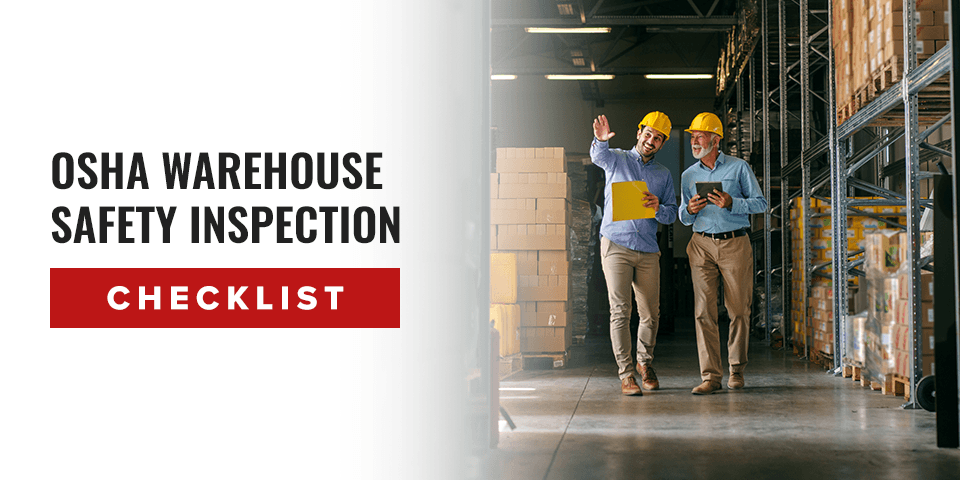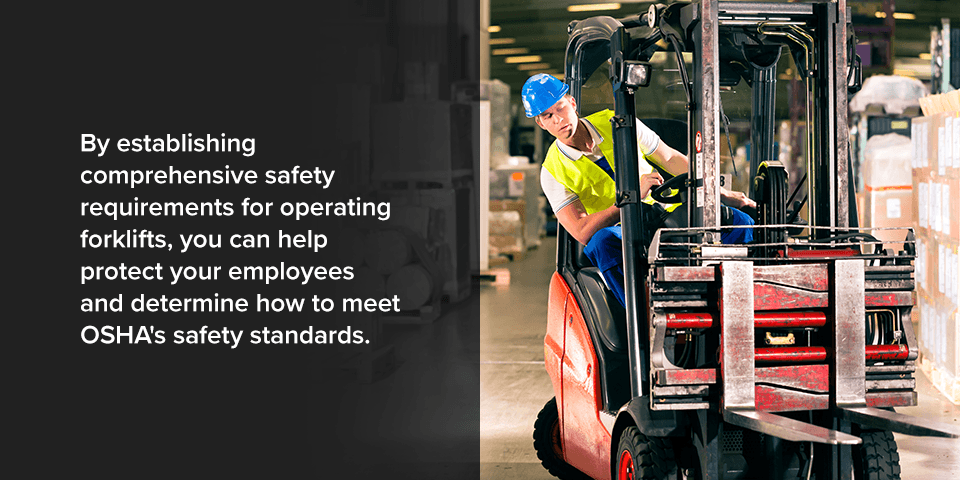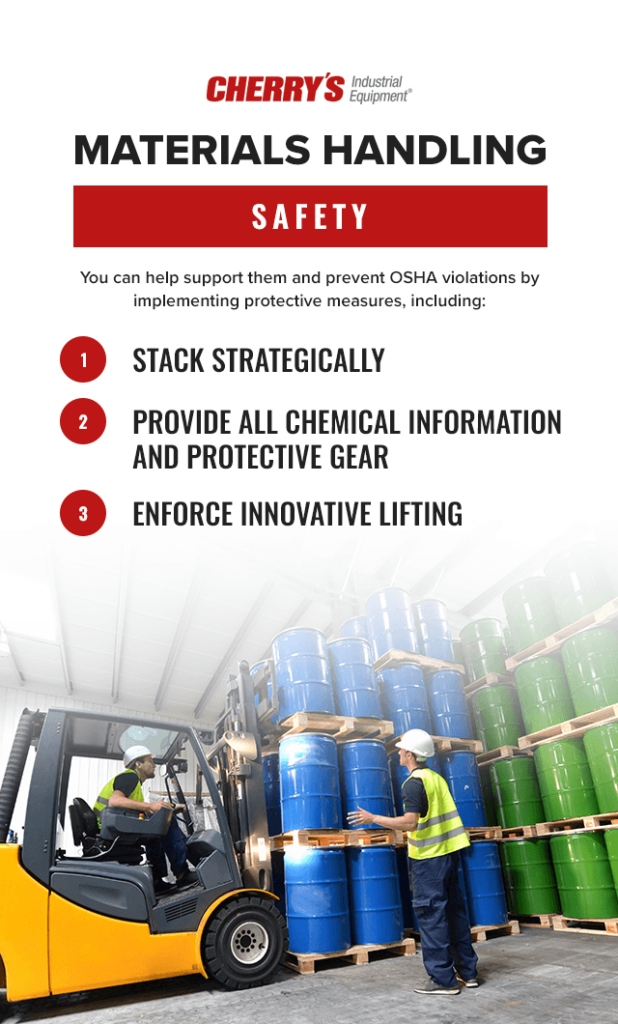
The Occupational Safety and Health Administration (OSHA) ensures that warehouses maintain proper health and safety conditions for employees. To make sure warehouses and companies abide by their standards, they send agents to conduct warehouse inspections.
Warehouse owners and production managers can prepare for agents with an OSHA inspection checklist, which helps highlight areas of common violations and potential dangers to employees. They can carefully maintain those areas and be ready when OSHA agents arrive for inspections.
Jump to Sections:
- Forklift Safety
- Loading Dock Safety
- Materials Handling Safety
- Electrical Hazards Safety
- Fire Hazards Safety
- Training Courses
- Hazard Communication
- Increase Your Warehouse’s Safety With Cherry’s Material Handling Today

Forklift Safety
Forklifts can pose serious dangers to warehouse employees, making it essential for production managers and warehouse officials to establish and enforce forklift safety equipment. In 2021, OSHA reported that over 95,000 employees experience serious injuries from forklifts every year, and over 100 die in forklift-related incidents.
One of the most common dangers of operating forklifts is the equipment overturning onto the driver. However, operating forklifts also comes with many other risks and threats to employees, especially without a carefully maintained and safe warehouse. To best protect your employees, follow the best safety protocol when handling forklifts, including:
- Check equipment and safety features: Before each forklift use, ensure your employees carefully check the equipment and relevant safety features. Many forklift accidents happen because safety equipment, like seatbelts and tires, is not in use or up to standard. You can help protect your employees by establishing check systems for forklifts so they can catch potential dangers before starting the machine.
- Retire and remove broken equipment: By regularly checking how your equipment functions before each use, you can quickly find any machinery not functioning to standard and mark it for repairs. However, you can further protect your employees and avoid confusion by removing forklifts marked for repairs from the warehouse, ensuring no employee accidentally uses damaged equipment.
- Maintain clean and clear passageways: You can ensure the safety of forklift operators by keeping aisles and passageways where forklifts pass through clear of larger items and other employees, allowing for easier navigation. Further, establish safety procedures to keep passages dry, so forklifts can move without slipping.
- Establish and enforce weight limits: When creating safety regulations for operating forklifts, help prevent forklifts from tipping by establishing weight limits for cargo. Communicate and mark weight tiers carefully, so your employees know what equipment they can use to lift and move items and where to store them safely.
By establishing comprehensive safety requirements for operating forklifts, you can help protect your employees and determine how to meet OSHA’s safety standards.
At Cherry’s Material Handling, we offer many types of high-quality equipment you can use to ensure forklift safety for employees and meet OSHA’s standards. Floor signs can help control traffic flow throughout your warehouse and guide forklift operators along correct routes while keeping employees on foot separate.
Loading Dock Safety
Like forklifts, loading docks account for several workplace accidents and injuries annually. Many loading dock injuries include forklift malfunctions and accidents where equipment falls from the docks, injuring operators and other employees. However, loading docks pose many unique dangers aside from forklifts, like falling products that hit employees and individuals falling from open docks.
As you prepare for OSHA warehouse inspections, protect your workers from loading dock dangers and prevent OSHA violations by implementing loading dock safety procedures, including:
- Establish speed and weight limits: You can protect employees navigating loading docks by establishing speed and weight requirements for all equipment and products. Speed limits will help ensure equipment stays in control and has time to prevent collisions or falls — in general, OSHA recommends equipment like forklifts to stay below 5 mph. Weight limits can keep docks stable so your employees and equipment stay safe while traversing them.
- Include visual markers for dock edges: To help prevent equipment and people from falling from the loading dock’s edges, add signs and other visible markers to let employees know when they are getting too close to the edge. Establish areas on the dock where it is safe for individuals to move and work with minimal risk of falls.
- Block off unsafe areas: OSHA recommends preventing access to spaces where employees can fall more than 4 feet down. Docks often have open spaces where workers can easily slip and obtain serious injuries. Protect your employees from these zones by using physical obstructions to prevent them from falling from docks.
While these OSHA inspection checklist items can help safeguard employees and avoid OSHA violations, you can also restrict access to docks and require trained and qualified officials to enter them. However, even eligible employees are at risk without the proper preventative measures.
Cherry’s Material Handling offers various types of guards you can install in your loading dock areas, including barriers, bollards, racks and railings. These physical features can prevent falls and restrict access, blocking off unsafe areas for employees and limiting where equipment like forklifts can go.

Materials Handling Safety
Working in a warehouse means your employees will be responsible for storing and transporting materials sent to your location. Whether they are handling them at loading docks or on forklifts or putting them on storage racks, they still face many hazards when interacting with materials. You can help support them and prevent OSHA violations by implementing protective measures, including:
- Stack strategically: Falling materials and crates can pose severe risks to employee safety. Avoid falling materials by requiring racks to have secure or anchored baseplates, setting stack height limits, designating lower shelves for heavier items and ensuring all stacks are level and straight. Implementing and enforcing smart stacking can help assure your employees’ material storage areas are as safe as possible.
- Provide all chemical information and protective gear: If your warehouse stores chemicals, you need to inform your employees of their risks, where these risks originate from, how to clean spills and what protective gear is required for handling chemicals. Offer this information in many ways, including training, information sheets and symbols on aisles or crates. It should be clear where employees can find protective gear and use it effectively.
- Enforce innovative lifting: While some equipment will require forklifts for transportation, you may have materials that employees can lift. If this is the case, protect your workers from pulling muscles or sustaining back and neck injuries by teaching them safe lifting habits. Encourage two-employee lifting techniques and work with engineers to design your warehouse and storage areas with easy lifting in mind.
Cherry’s Material Handling offers many tools for handling materials, including chemical substances. Our industrial and chemical cabinets allow you to store hazardous materials safely, ensuring your employee’s protection. You can further protect your workplaces and direct traffic in storage areas with floor signs and other indicators.
Electrical Hazards Safety
Electrical hazards provide several types of dangers to employees, from shocks to third-degree burns. Warehouse operators and production managers should follow OSHA guidelines about preventing and protecting against electrical hazards, including:
- Limit personnel access: If you have areas with several electrical hazards, limit them to only employees with specialized training to interact with the equipment. Use signs to notify employees that they can’t pass specific points and alert them to dangers after passing those points.
- Provide adequate protective gear: Make it clear what protective gear is necessary to protect employees from electrical hazards and where they can find that gear. All workers with access to areas with electrical hazards should receive training that teaches them how to use protective gear and explains how it works.
- Implement lockout/tagout (LOTO) procedures: LOTO procedures help employees work on powerful equipment without exposing themselves to electrical hazards by ensuring machinery fully shuts down before they can use it. Lockout keeps the equipment off while maintenance occurs, and tagout ensures only the employee who placed the lock on the machine can unlock it, protecting other workers.
Safeguard your employees from electrical hazards by clearly marking dangerous areas and the locations of protective gear. Signs from Cherry’s Material Handling can offer you the communication measures you need to relay dangers to your staff and lead them to protective tools.
Fire Hazards Safety
All workplaces need to have an emergency plan that includes what will happen in case of a fire, especially in warehouses where fire hazards are the most common risk to employees. While it can be challenging to predict what happens during an OSHA inspection, expect agents to check your fire prevention and protection policies, such as the following:
- Identify fire extinguishers: Mark where employees can find fire protection and preventative equipment, like fire extinguishers. You can use signs to direct employees toward fire extinguishers, but you should also cover these locations during safety training so workers know where they all are.
- Mark fire exits: In case of a fire, your employees will need to vacate the premises for their safety. Use signs to mark fire exits they can safely take when a fire breaks out. You should also establish a fire plan, which employees can follow to exit the building and efficiently assemble somewhere outside.
At Cherry’s Material Handling, we offer signs you can use to direct traffic around your warehouse, including ones to keep employees safe during a fire. Whether you need to mark a fire extinguisher or designated fire exits, you can find signs at Cherry’s.

Training Courses
As you determine how to pass an OSHA inspection, consider investing in training courses for new and current employees. Help prevent injuries caused by misinformation or incorrect handling of machinery and hazards by requiring many courses for employees that cover a wide range of topics, including:
- Ergonomics training: Warehouses strive for efficiency, but they don’t need to sacrifice safety to do so. Provide ergonomics training to your employees to teach them how to carefully and correctly lift heavy equipment, move through helpful stretches and exercises and understand the signs of overworking. Ergonomics training can also be a great opportunity to express standards for breaks and resting, so your employees know how to prevent overworking and injuries.
- Equipment training: To help prevent forklift, dock and other equipment accidents and injuries, require that all employees working in those areas receive specialized training. While this can help you keep unauthorized workers away from the equipment, you can also ensure that individuals using the machinery understand risks and how to prevent them.
- Chemical training: Because warehouses often store and transport many hazardous chemicals, production managers can protect employees from chemical-related injuries by offering training courses covering handling and cleaning chemicals. Training can also introduce employees to the protective gear available to them and teach them to use it correctly to protect themselves from chemicals effectively.
- Specialized task training: Managers can save time by dividing training sessions into general knowledge for all employees and specialized task training. Managers can customize specialized task training to fit specific positions’ potential dangers and responsibilities to help protect employees and prevent injuries related to their everyday tasks.
While training all new employees is essential, you will also need to make sure your existing ones receive consistent and up-to-date training. Requiring individuals to take training courses each year to refresh their knowledge about existing policies and inform them of changes can ensure they remember how to protect themselves.
Hazard Communication
For employees to stay safe while working, managers need to communicate potential dangers to them and prevent or treat these. Training courses are a great way to begin hazard communication, but employees will require long-term, consistent communication they can rely on daily to keep themselves safe at the warehouse. Essential forms of hazard communication include:
- Signs: To communicate dangers to your employees in the warehouse, signs are a must. You can use signs to relay several messages, from directing traffic and access to communicating specific hazards to team members. Signs are a great way to visually remind employees of the dangers they face every day and guide them along with safety protocols.
- Labels: Like signs, you can use labels to explain dangers with written information. Whether labeling chemical names or weight limitations, you can include more information on labels than you can with signs while still providing short, quick information to employees. Many labels can incorporate symbols so you can relay even more essential information, like qualification restrictions and specific hazards.
- Material Safety Data Sheets (MSDS): For handling and storing chemicals and other hazardous substances, you need to have MSDS on-site and available to all employees. These sheets should clearly state all information about the substance, including any potential hazards, how to clean up spills and what protective equipment is required to handle and store the chemical. Tell employees how to find and read MSDS during training and encourage them to regularly check these sheets before interacting with chemicals to help prevent OSHA violations.
Communicating hazards is essential for keeping employees safe and avoiding OSHA violations. Determine what areas you need more communication in by using an OSHA inspection checklist, and learn more about the products from Cherry’s Material Handling to help implement better communication skills. With various tools, including signs, you can find the best way to communicate hazards to your employees.

Increase Your Warehouse’s Safety With Cherry’s Material Handling Today
In warehouses, your employees face several hazards daily that can pose serious threats to their health and safety. Using an OSHA inspection checklist can help you better identify and eliminate dangers to your employees.
Part of the elimination process includes implementing protective and preventative tools to keep your employees safe as they work. At Cherry’s Material Handling, we offer several kinds of equipment you can use to protect your workers, from floor signs to direct traffic to containers for handling and storing hazardous materials.
Contact Cherry’s Material Handling today to learn more about how we can better protect your warehouse, or call us to chat with one of our representatives at (877)-350-2729.